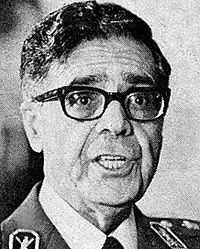Gholam Reza Azhari
| Gholam Reza Azhari | |
|---|---|
 | |
| 73rd Prime Minister of Iran | |
| In office 6 November 1978 – 4 January 1979 | |
| Monarch | Mohammad Reza Shah Pahlavi |
| Preceded by | Jafar Sharif-Emami |
| Succeeded by | Shapour Bakhtiar |
| Personal details | |
| Born | 1917 Shiraz, Iran |
| Died | 5 November 2001 (aged 83-84) Fairfax County, Virginia, United States |
| Alma mater | National War College |
| Religion | Islam |
Gholam Reza Azhari (1917 – 5 November 2001) was a military leader and Prime Minister of Iran.
Early life and education
Azhari was born in Shiraz in 1917.[1] He was a graduate of Iran's war college. He was also trained at the National War College in Washington in the 1950s.[1]
Career
Azhari worked at the CENTO.[2] He was appointed chief of staff of Iran's armed forces in 1971 and his tenure lasted until 1978.[3] He served as interim prime minister of a military government until a civilian government could be chosen. He served as prime minister from 6 November 1978 to 31 December 1978.[4][5] He formed the first military government in Iran since 1953.[3]
On 21 December 1978, Azhari, then the prime minister, told U.S. Ambassador to Iran William Sullivan that, "You must know this and you must tell it to your government. This country is lost because the Shah cannot make up his mind."[6] Azhari had a heart attack in January 1979[7] and resigned on 2 January.[8] Then he was succeeded by Abbas Gharabaghi as the chief of the army staff.[9] Shapour Bakhtiar succeeded Azhari as prime minister.[9][10] On 18 February 1979 Azhari was retired from army in absence.[11]
Cabinet
His cabinet was composed of 8 members (5 military men and 3 civilians):[12]
- General Gholam Ali Oveissi, Military Governor of Tehran (Labour and Social Affairs),
- Lieutenant General Nasser Moghaddam, head of the Security Police (Energy),
- General Abbas Gharabaghi (Interior),
- Lieutenant General Abdol Hassan Sa'adatmand (Housing and Development),
- General Gholam-Reza Azhari (War)
- Amir Khosrow Afshar (Foreign Affairs),
- Mohammad Reza Amin (Industry),
- Karim Motamedi (Posts and Telecommunications)
However, it is also reported that the government was of eleven men and six of them were military officers.[13]
Honours
Later years and death
Azhari suffered a heart attack while serving as prime minister.[7] After leaving office he went to the US in January 1979 for heart surgery at Bethesda Naval Hospital.[7] After surgery he did not return to Iran and settled in McLean, Virginia.[7] In the immediate aftermath of the revolution, Ayatollah Sadegh Khalkhali, a religious judge and then chairman of the Revolutionary Court, informed the press that the death sentence was passed on the members of the Pahlavi family and former Shah officials, including Azhari.[14]
He died of cancer in Fairfax, the US, on 5 November 2001.[7]
See also
References
- ↑ 1.0 1.1 1.2 "Index At-Az". Rulers. Retrieved 31 July 2013.
- ↑ Rubin, Barry (1980). Paved with Good Intentions. New York: Penguin Books. p. 220.
- ↑ 3.0 3.1 Raein, Parviz (6 November 1978). "Shah decrees military control in Iran". The Day (Tehran). AP. Retrieved 4 November 2012.
- ↑ Mansoor Moaddel (January 1994). Class, Politics, and Ideology in the Iranian Revolution. Columbia University Press. p. 160. ISBN 978-0-231-51607-5. Retrieved 25 July 2013.
- ↑ Nikazmerad, Nicholas M. (1980). "A Chronological Survey of the Iranian Revolution". Iranian Studies 13 (1/4): 327–368. Retrieved 31 July 2013.
- ↑ Sullivan, William H. Mission to Iran. New York: W.W. Norton and Company, 1981. p. 212.
- ↑ 7.0 7.1 7.2 7.3 7.4 "Gholamreza Azhari, 83; Briefly Served as Iran's Prime Minister". Los Angeles Times. 18 November 2001. Retrieved 31 July 2013.
- ↑ "Iran Cabinet". The Telegraph. 2 January 1979. Retrieved 31 July 2013.
- ↑ 9.0 9.1 "Shah selects chief of staff". The Palm Beach Post (Tehran). 5 January 1979. Retrieved 4 November 2012.
- ↑ Jessup, John E. (1998). An Encyclopedic Dictionary of Conflict and Conflict Resolution, 1945-1996. Westport, CT: Greenwood Press. p. 46. – via Questia (subscription required)
- ↑ Roberts, Mark (January 1996). "Purge of the Monarchists". McNair Papers (47-48). Retrieved 29 August 2013. – via Questia (subscription required)
- ↑ "General Gholam Reza Azhari meets the Foreign Press (1978)". Iranian. Retrieved 31 July 2013.
- ↑ Jahangir Amuzegar (1991). The Dynamics of the Iranian Revolution: The Pahlavis' Triumph and Tragedy. SUNY Press. p. 255. ISBN 978-0-7914-9483-7. Retrieved 1 August 2013.
- ↑ "No Safe Haven: Iran's Global Assassination Campaign". Iran Human Rights. 2008. Retrieved 4 August 2013.
Sources
- 'Alí Rizā Awsatí (عليرضا اوسطى), Iran in the Past Three Centuries (Irān dar Se Qarn-e Goz̲ashteh - ايران در سه قرن گذشته), Volumes 1 and 2 (Paktāb Publishing - انتشارات پاکتاب, Tehran, Iran, 2003). ISBN 964-93406-6-1 (Vol. 1), ISBN 964-93406-5-3 (Vol. 2).
| Political offices | ||
|---|---|---|
| Preceded by Jafar Sharif-Emami |
Prime Minister of Iran 1978–1979 |
Succeeded by Shapour Bakhtiar |
| Military offices | ||
| Preceded by Abbas Ghare-Baghi |
Chief commander of Imperial Army 1971 –1977 |
Succeeded by Feridoun Jam |
| ||||||||
| |||||||||||
.svg.png)